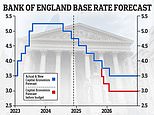What is 'COPE' and why has it vanished from state pension statements? STEVE WEBB replies
- Has your pension question been answered? Read Steve Webb's replies
- Most popular Steve Webb columns on the state pension: The 14 hot topics

State pension payments: Department for Work and Pensions received a lot of feedback from people confused by the 'COPE' figure
I recently received my state pension statement as I will qualify for the full state pension when I am 66 in November.
However, it does not state the 'COPE' - the 'contracted out pension equivalent' - I have built up in previous years when I was contracted out while employed in the civil service.
My COPE was approximately £50 a week on pension forecast statements but now seems to have disappeared when I go online.
I'm beginning to wonder if I have misunderstood COPE and that this figure is purely information only and not a valid payment that I will actually receive in my hand? Can you clarify?
SCROLL DOWN TO FIND OUT HOW TO ASK STEVE YOUR PENSION QUESTION
Steve Webb replies: In recent years I have had more questions about the mysterious 'COPE' figure which appears on state pension forecasts than almost any other topic.
This week I'll clarify what it is – and where it has gone.
The story starts back in 1978 when the Government of the day introduced an additional state pension which people could build up on top of their basic state pension.
This pension was snappily known as the State Earnings-Related Pension Scheme or SERPS for short.
The idea was that all workers should be able to build up an earnings-related pension on top of the standard basic rate.
However, when SERPS was introduced, millions of workers were already building up an earnings-related pension via their occupational pension scheme.
It clearly made little sense to charge all workers extra National Insurance to pay for the additional state pension meaning that one group of workers was paying for two earnings-related pensions – one from their employer and one from the state.
To overcome this problem, the idea of 'contracting out' was applied.
In simple terms, workplace pension schemes were given the option of providing earnings-related benefits instead of the state doing so.

Got a question for Steve Webb? Scroll down to find out how to contact him
The employer and employee in such schemes was allowed to pay a lower (contracted out) rate of National Insurance contributions.
In return, the scheme had to promise to provide a pension at least as good as the SERPS pension the worker could otherwise have built up.
This was known at the time as a Guaranteed Minimum Pension (GMP).
When people retired under this system, their state pension was worked out as if they had always been in both parts of the state pension system – basic plus SERPS.
But a deduction was then made to reflect the fact that they paid less in and that their workplace scheme had promised to replace part of their state pension.
When the new state pension was introduced in 2016, a decision had to be made about how to treat the millions of workers who had past periods of contracting out.
The goal of the new state pension was to simplify things and pay everyone a standard flat rate amount. This would have made pension planning and communication a lot easier.
But to simply ignore decades of paying in at a reduced rate – and pay the full flat rate regardless – would have been totally unfair on the remaining workers who had always paid full NI in order to get a full pension.
The compromise was to make a one-off deduction from people's state pension as at 2016, but then allow them to 'burn off' this deduction through post 2016 contributions.
Not surprisingly, not many people had the time to follow all of this logic, and were confused and angry when they didn't simply get the full new state pension that they had heard so much about.
My successors as pensions ministers had to spend a lot of time explaining why people weren't getting the full flat rate, and so one of them came up with the concept of the COPE – the 'contracted out pension equivalent'.
This figure was meant to be a signal to people that something had been knocked off their state pension because of past contracting out but they should be getting a similar figure instead from a workplace pension.
The problem was that the COPE figure itself confused people.
This was particularly the case where people had contracted out into a 'pot of money' type pension which may not have actually delivered the COPE figure because of poor investment performance or low annuity rates.
There was also considerable confusion as to whether the headline state pension forecast figures which you could see online had already taken account of the COPE figure or whether you needed to mentally deduct the COPE figure to work out what you would really get.
In fact, you could always ignore the COPE figure – it had already been taken into account as part of the calculation, so you did not have to take it off again.
Several readers have been in touch to say that the COPE figure now seems to have mysteriously disappeared.
I understand that Department for Work and Pensions had received a lot of feedback from people confused by the figure and so they decided that from April 2024 it would no longer appear.
In your individual case, your COPE figure was always flagging to you that you also had a 'contracted out' pension – in your case with the civil service – and that your state pension would be topped up by a workplace pension worth at least the COPE number.
Nothing has changed in this regard.
The bottom line is that you could always ignore the COPE figure.
It was designed to help people understand that they were short of the full pension for a reason, but in the end it caused more confusion than it saved.
I, for one, am pleased to see the quiet death of the COPE.
SAVE MONEY, MAKE MONEY
Affiliate links: If you take out a product This is Money may earn a commission. These deals are chosen by our editorial team, as we think they are worth highlighting. This does not affect our editorial independence. *Chase: Cashback available for first year. Exceptions apply. 18+, UK residents.
















































































